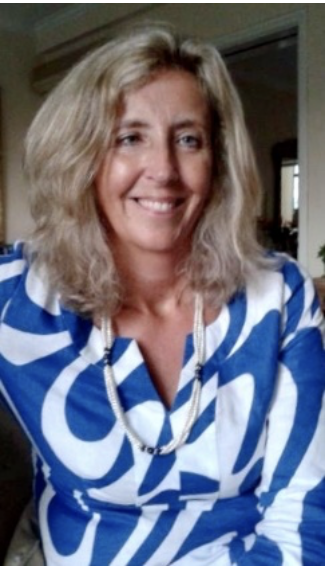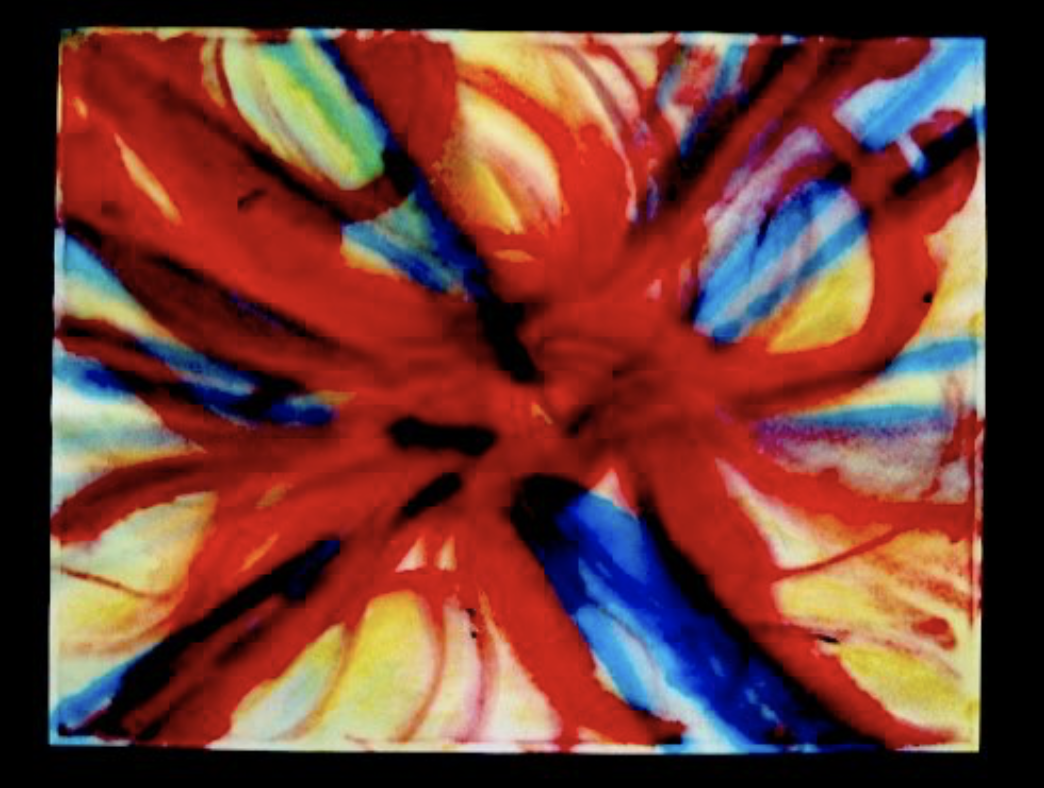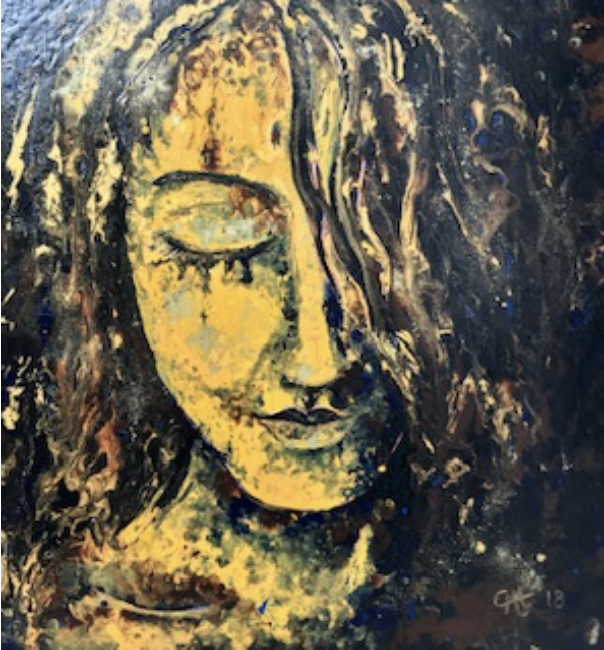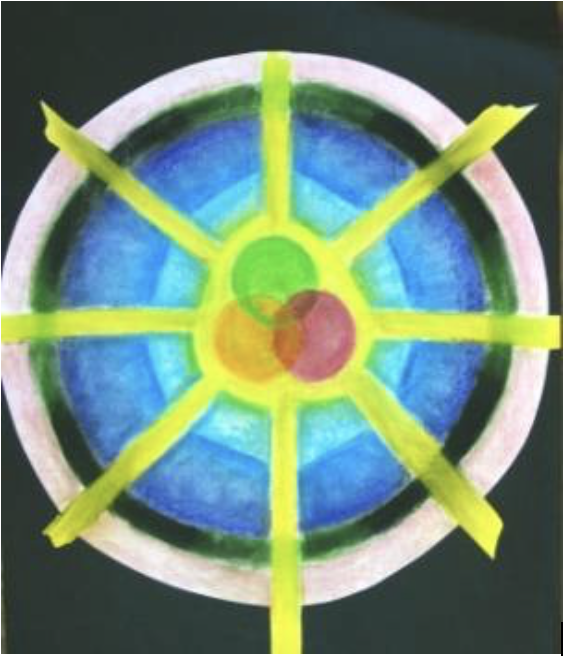Catriona Alderton on Art Therapy,
Colour, Resilience,Tobias School of Art Therapy,
Prince's Trust, Street Talk and
Art as a Tool for Empathy

Many in the world have suffered from trauma, violence as well as many other abuses. Often we get distressed about the way the world is sometimes going, about how we feel, or about how people have acted towards us or even how we may have reacted. As we are connected through the wires, perhaps we are also disconnecting, as the world seems to be ever more reliant on the machine and less on each other. And then you meet someone like Catriona Alderton and you are reminded of how the world could and should be, a world of empathy and non judgemental. Speaking to Catriona, hearing about her work, is like being hugged by a big heart of light and care, as her endless passion is to ensure that people who have been through difficult times have an arena or tools to express themselves and are helped through their difficulties. She is on a quest to help vulnerable women and Yound People not feel alone. Art is a great tool to aid in this. Our conversation divulged deep into art, technology, anxiety, our feelings and how art therapy can help us all, no matter what are circumstances may be.
Can you share with us a little of your journey that made you interested in art and later art therapy?
My mother painted in oils, so I’ve been painting and drawing my whole life. It’s part of who I am. The traditional part of my early career was in Counselling, then HR. Art therapy enabled me to combine my great loves: art, people and counselling.
When I was growing up, we lived overseas. Art was my constant companion, often the only consistent element. From early on, I made ‘responsive art’ - putting my experiences, emotions and dreams onto paper. I found this very cathartic, and it helped me work through problems, build resilience and work out who I was. It worked for me so I began to realise it could work for others.
When I was in my early 20’s I lived in Belgium, working as a family welfare officer. I received basic counselling training, which I used in crisis situations. I saw how people who have been traumatised or shocked can have problems verbalizing, so even then I thought it might be much easier using art to explain feelings and handle emotions. I wasn’t aware of art therapy at that point, or I’d have trained much sooner than I did!
My interest in art therapy also came about years ago, after I was in a taxi which was driven by a veteran soldier who had been deployed in Afghanistan. He was suffering from PTSD and had been offered talking and writing therapies, which hadn’t helped, because, as he explained, he had joined the Army at a young age as talking and writing were not his main strengths. He was bravely working with his issues alone, and that courage got me interested in how to help people without necessarily needing words.
What is Art Therapy and how does it work? Is there a particular process or is it more a case by case procedure?
Art therapy uses different art materials to work with issues which people may find hard to put into words. For the person seeking art therapy, no experience of art is necessary: it’s about process, not making beautiful art, although that can happen!
The individual works with a qualified registered therapist. Art therapy connects with our unconscious. Materials, colour and form are used to identify, express and work with emotions and feelings. Many people who have experienced trauma bury it deep as they can’t deal with it. Sometimes, they make an edited version of their ‘story’, which they can share verbally, while keeping feelings and responses suppressed. That may work for a time, the problem is, sooner or later, those buried issues can resurface. Art therapy can help access these memories, allowing unresolved trauma and issues to be safely worked through with the therapist’s support.
I don’t work in a set way. Each client is an individual and often the issues which brought them to therapy are the tip of the iceberg. So whatever I know of them and their history, I still do take the time to get to know them, build a therapeutic relationship and gain their trust. Initially, I offer them a choice of materials and suggest they produce 1-3 works, which lead us into the therapy.
This is where experience and training come into their own, helping me to assess, by observing my client’s responses to the materials, colours and their work. Often, the most complex hidden issues are visible in an image, usually in the parts which they dislike, or which make them feel uncomfortable. When this happens, a gentle appropriately placed question can lead to a client having the courage to work through a long-buried memory which has surfaced, even leading to them visually transforming it into something else. This process can be really empowering and can bring huge relief, resolving issues and enabling clients to move forward.

This set of images represents a 3 stage therapy process. The above client, having worked to be able to express anger, is afraid she will lash out and be unable to control her emotions.The first picture, on the left, represents what, for the client is the terrifying possibility of uncontrollable, raging anger. The second image created in the process is the one at the end. This represents the calm, positive emotional state the client wishes to experience. To be able to express anger cleanly, and move forward. (art therapy images by anonymous client-Images are shared with the client's consent.)
What are the different ways that Art Therapy can help people?
As with talking therapies, there are different types of art therapy. I’m trained in Transpersonal Art Therapy which is person-centred. I always start where the person already is and move at their pace.
I believe that art therapy should be experienced by everyone. It can really make a difference, from a well-being perspective, it can relieve stress and be nurturing, through to aiding trauma recovery and supporting life-limiting conditions.
Our world is high-octane and very left-brained. Huge emphasis is placed on the importance of analytical thinking and problem solving. The pace of life is relentless and it is increasingly difficult to find time to recuperate and switch off due to the constant bombardment of noise, advertising and the omnipresent mobile phone. We are constantly available. All of this can eventually lead to burnout and mental health issues, all of which as we know are on the rise.
Most of my clients have mental health issues and complex physical needs. Depending on their condition when we meet, we work with whatever they can manage at the time or what has come up for them between sessions. In some cases, if they’re physically unwell and unable to do much, simply working with certain colours and themes can distract them and ease their discomfort.
Art therapy can be very beneficial to people who speak little English, or clients who have suffered childhood abuse. Vocalizing their issues can be difficult and incredibly painful. Creating art in a therapy session can be a great way of making these issues ‘safe’ and working with them from a distance. If an issue is overwhelming, the artwork can be moved away or covered up, while you support the client to work out how to change it, in order to move forward.

‘The swirling fire of internalised anger’ - This is a visual expression of internalised anger. Hot and burning, and icy cold, colours burst outwards, hoping to find a safe outlet. As this is not possible, the client buries the anger deep inside. (art therapy images by anonymous client-Image is shared with the client's consent.)
How is a painting interpreted? Are there certain signs or codes that may feature, that can be read in the artwork?
I hate to disappoint but we don’t interpret artworks as such. While there may be certain symbols and images which are archetypes, or possible indicators of certain medical conditions, the emphasis is more on the way the client works, how they handle the medium and their responses to it. I think of, have they applied the medium heavily? Lightly? Are they working in a controlled fashion? and so on. Interpreting a work is very subjective and we are individuals, so we experience things differently. The therapist may ‘see’ things in a work, but what really interests us is what the client experiences.
For example, if a client chooses to work with black or red that doesn’t necessarily mean they’re angry, or in a dark place. It may simply mean that they like red and black. One of my clients (who has given me permission to talk about her work) portrayed a horrific experience as a garden of colourful flowers. The image was pretty and appeared non-threatening, until she explained what the flowers and colours signified for her.
When a client is working, I may gently enquire what the image or part of it, means to the client, especially if they display a reaction (positive or negative) to it. This can help open a dialogue.
So it's not necessarily that colours mean certain things? Or does that depend on what is being drawn and the overall picture?
Sometimes certain colours or combinations may offer clues to what is going on, especially when several works are viewed together. Then you can see if any patterns are emerging. Colours can also affect our emotions and feelings, so in the appropriate context they can be very powerful. A client who is feeling vulnerable may have their boundaries gently reinforced by blues and greens. I would be very careful if working with someone who had a blood disorder, as vermillion (bright, orange-red) can stimulate blood flow.
Of course, the entire image is very important, so it all needs to be taken in context.
Can or have you seen people try to mask their feelings through art, or are the tools from art therapy able to see through that? Or can the process of creating art itself intercept someone trying to mask their emotions?
Because art therapy connects with emotions and the unconscious, I’ve often found that even if people have long avoided an issue or have no idea of how to begin working with it, something will happen which begins the process. The therapeutic alliance between client and therapist is crucial, since the therapist is not only supporting them throughout the process but ensuring they feel safe while they explore their issues and emotional responses.
Is there a difference between painting or drawing on your own or for oneself and the emotions that may evoke, and doing it with the purpose of and for therapy?
Art of any kind can be therapeutic and relaxing. Creative activities activate our right brain, which is generally less active than our left brain. This can boost positive chemicals and endorphins making us feel good while simultaneously reducing stress. It can literally give our brain downtime!
Of course, anyone working creatively (artists, dancers, musicians) can pour their feelings into their craft, which can be both cathartic and empowering.
However, working with a therapist is very different to working alone. The therapist holds a safe and supportive space. This is crucial, as suppressed issues can become visible in an image, which can be very unsettling for the client. It’s very hard to do such deep work alone.
The therapist can suggest ways of transforming an image, which can help the client resolve the issue positively and move on. Working with trauma can be very frightening and the temptation is to lock it away again. A good therapist supports the client, making suggestions and helping them resolve the trauma, in order to move forward. It’s very delicate work and requires skill and resilience.
I am on a therapeutic journey with each of my clients and it is a privilege to support them through it.
Personally, I make ‘responsive’ art creating works which are inspired by my clients, their resilience and my responses to their stories. This is an important part of my life- ‘creative self-care’! I also feel the images I produce honour the strengths and courage of my clients.
.png)
‘Colours of my Heart’ by Catriona Alderton "with a client’s permission, I drew her profile, then painted it with her favourite colours."

La Fille aux Yeux Fermés by Catriona Alderton
You work with the Tobias School of Art and Therapy, could you tell us about the school and the importance of teaching Art Therapy?
Tobias is unique. It’s a nurturing environment run by really special people. It has an ‘outside the box’ approach, and students are well supported to ensure they become resilient therapists who are able to work with the challenges their clients experience. Training is skills-based and practical with the importance of knowing how to use art materials and their powerful effects, as well as knowing about colours, since using certain colours in the process of art therapy can be beneficial for clients with certain conditions, while some colours may be contra-indicated.
The course in ‘Transpersonal Art Therapy’ is very comprehensive. It includes counselling training, practical skills (experiencing and working with colour, the Anthroposophical medical model), research, and integrating theory with practice. The emphasis is on enhancing wellbeing, sometimes using the Nurturing Arts. Students also work with the Expressive Therapies Continuum, which has a ‘bottom up’ approach, i.e. supporting an individual to identify their somatic and sensory responses to issues, in order to help them resolve their issues gently but effectively.
The mind-body connection is so important and I feel can often be overlooked. By supporting and nurturing the whole person, we can help them build resilience and move forward. Art therapy is an important resource to have, especially when we think of all the sectors it touches and people it has helped; for instance, Tobias graduates have worked in pretty much every sector - mental health, schools, hospices amongst others.

Mandala- coloured circles in the centre represent family, work life and creativity overlapping. The golden circle represents happiness, surrounded by nurturing shades of blue. The black circle is a solid boundary, sealing the mother into family life. Nurturing but isolating. During the process, golden paths were created to the outside, forging new connections to future possibilities outside family life.
With technology being ever more present in our lives, do you think as an antidote to the downside of technology, that art Therapy should become more of a norm in our lives and though are present in schools and hospitals and maybe some businesses do art therapy workshops, that it should be more of a regular feature and introduced customarily in institutions?
Technology affects our minds and bodies and the long-term effects won’t be truly evident for many years to come. However, we know already that the system used by many platforms of having one’s comments and images ‘liked’, triggers Dopamine in the brain. That’s the hormone associated with addictions. Some apps were apparently designed to be addictive. Also, the younger generations are growing up feeling they’re missing out, as other people’s lives appear ever more perfect. The desire to be in constant contact means the brain doesn’t get to rest, and I think for some, the boundaries between reality and fantasy have blurred. It’s hardly surprising therefore that mental health issues are on the rise.
Art therapy not only helps resolve problems and traumas, it can help with the management of behavioural problems, foster self-awareness, build self-esteem, teach social skills and, as I mentioned before, from a purely well-being context, can help people slow down and de-stress.
There are some great artworks that are labelled as “Outsider Art”, what are your thoughts on “Outsider Art” and the term used?
In my opinion, art should be about originality and creativity. The term ‘Outsider art’ was coined in the 1970’s to describe art made by people with physical and mental illnesses and those on the margins of society. It has since expanded to include the self-taught. I dislike labels and feel the term is outdated and dismissive. It creates a feeling of superiority which I don’t think reflects the reality. I think the term creates barriers which politicise art and creativity. Art is a powerful visual communication and should have as much right to freedom of expression as free speech.
The work of ‘Outsider’ artists is gaining in popularity all over the world: it can be highly original and is often not led by trends. ‘Outsider’ artists can be highly skilled. Learning how to manipulate materials by yourself in order to make your own art can be lonely and difficult- it requires determination and persistence and builds resilience.
I believe that art should come from the heart. Many artists create art because it helps them to move forward, it’s part of what keeps them alive.
If there has to be a label, the term ‘Art Brut’ maybe better captures the feeling of authentic, intensely personal experiences which characterize creativity, tutored or otherwise.
You work with the Prince’s Trust, so that Young People can be helped through any issues or if they highlight that they may have some mental health problems. How has art therapy impacted the Young People and how can it help with mental health?
Yes and as I’m also Tobias’ Placement Coordinator, I help art therapy students find their clinical placements and then support them while they are at their placement. They have to do 120 days of placements in different sectors and some of the students go to work with the Prince’s Trust. We have a great relationship with the Prince's Trust and have been working with them for several years. The Young People at the Prince’s Trust respond really well to art therapy and Tobias’s Person-Centred approach. They work in groups or 1:1 sessions, as appropriate. The Young People our Tobias students have worked with, have found that art therapy not only helps with personal issues but can boost their self-esteem and confidence and help them get the most out of the Trust’s Programmes.
At Street Talk you work and provide therapy to vulnerable women who have either suffered from trafficking, domestic violence or are trapped in street prostitution and sometimes rough sleeping, how have they reacted towards art therapy? And how have you seen art therapy help in the process of recovery?
I’ve been working with Street Talk for almost three years, in a hostel which is a safe house and a drop-in for vulnerable women. Street Talk partners with charities in London, taking therapy to the women at hostels and drop-ins. Some of our therapists offer talking therapy, some work with art therapy.
Art therapy can be very beneficial to trafficked women who don’t speak much English, or those who struggle to verbalize. Some are traumatised before they learn to speak and revert to their early years when dealing with their situation. Art is more easily accessible and helps deal with that.
My clients have multiple issues and complex needs. Their stories can be distressing but their resilience and ability to survive and come through everything with appropriate therapeutic support is incredible.
What are your hopes for the future of Art Therapy?
I’d love art therapy to be widely funded, to enable therapists to work wherever they are needed, from corporate well-being sessions to work with people with life-limiting conditions, and everything in between. That already happens - but funding is so limited there’s a lot of competition and a fair amount of politics within the sector. I feel that’s wrong; it detracts from what’s important, which is helping people. I’d also like to see the number of sessions in the NHS increased - many of my clients have previously accessed therapy through the NHS which then ended before their issues were resolved, which can be hugely detrimental to their wellbeing.
Support for therapy students would be fantastic. All Tobias Art Therapy students undertake placements from their Second Year, and are doing fantastic work in the fields of mental health, hospices, with trafficked women, in schools and PRUs (Pupil Referral Units), among others. The College supports the students through placements, but placement providers are expected to contribute something towards their costs, which include materials, supervision and travel. However, many organisations struggle to do this, which increases the burden on the student. It would be wonderful if some of these costs could be funded from elsewhere.
I’d also like to see more research into the efficacy of art therapy. Until recently, it has been hard to evidence. However, neuroscientific research is becoming ever more efficient and is beginning to evidence the positive effects of art therapy. I plan to do some research myself, so watch this space!
You have worked in different countries and with different communities, art and our emotions are tools and attributes that connect us across the world, do you think that there should be more attributed to art as a connector or a tool that can heal us?
Absolutely. I feel we all need hope and beauty in order to not just survive, but evolve. Art can help reconnect people with their emotions, whether creating or observing. It’s powerful and bypasses language.
Being able to face and work with our emotional responses to stimuli or events is, I feel, crucial. People can be afraid of their emotions. Being in touch with emotions can make people feel they’re not in control, so they sometimes bury them deep. If that happens too often it causes long-term damage, which can resurface as mental health issues, or on a physical level like anorexia, self-harming in different ways - alcohol, drugs, cutting, over-eating, etc.
Our emotions are what makes us human. A society which isn’t allowing itself emotional self-expression is a terrifying thought. Connecting with our emotions and being able to use them appropriately is I feel crucial to our survival as a species. Emotional intelligence enables us to feel empathy … without empathy, where would we be?
Catriona Alderton Is a qualified Arts Counsellor and professional artist. She primarily uses art therapy to support vulnerable women, including those who have been trafficked and abused. She is also an Emmet Technique Practitioner and is completing certification for Delta Wave Therapy (Havening Techniques). Her aim is to draw together the strongest combination of therapy options, calibrated to need. Catriona has a deep interest in exploring spirituality and the creative process from a multi-faith and cross-cultural perspective, building on her experiences of living in Europe, Asia and Africa. She has worked with Tobias School of Art Therapy, Prince's Trust and Street Talk.

Spirit of Freedon, Spirit of Resilience, Spiriti of Peace
By Catriona Alderton
